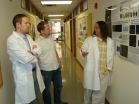COLUMBUS, OH, March 19, 2012 (Press-News.org) When people don't feel well, they see a doctor. They probably assume that the doctor will not spread anything to them to make them sicker. Ohio residents may be disturbed to find out that hygiene in hospitals is not as high of a priority as one would expect.
Hospital-acquired infections are the fourth leading cause of death in the United States. A 2004 study done by the American College of Physicians found that only 57 percent of doctors washed their hands when they were supposed to. The study also showed that the busier the doctor was and the more patients needing to be examined, the less likely the doctor was to engage in proper hand washing. If you have been harmed due to a hospital-acquired infection, contact an Ohio medical malpractice attorney to discuss your legal options.
Many attempts have been made to address these statistics and encourage medical personnel to wash their hands. One hospital's recent attempt at addressing the problem was written about by The New York Times. The hospital installed cameras by every sink or hand sanitizer in a section of the hospital. The employees knew about the cameras, yet only 6.5 percent of medical personnel washed their hands within 10 seconds of entering or leaving a room.
The next thing the hospital tried was installing light boards showing the compliance rates along with words of encouragement. After the signs were installed, 81.6 percent of medical personnel washed their hands within 10 seconds of entering or leaving a room. The compliance percentage increased to 87.9 percent after the light boards were in place for over a year. The experiment showed that people will wash their hands more regularly when they know for sure that they are being watched.
Another recent incentive is that Medicare stopped reimbursing hospitals for treating patients suffering from hospital-acquired infections in 2008. Treating a patient for a hospital-acquired infection can cost upward of $15,000.
The concern over the spread of disease in a hospital setting has come to the forefront for most hospital administrators. Fortunately, more hospitals are now willing to invest time and money into efforts to ensure their medical personnel are taking the necessary steps for good hygiene.
If you or someone you know has been injured in a hospital through neglect or a medical error, contact an Ohio medical malpractice lawyer for an assessment of your case.
As one of the oldest personal injury law firms in central Ohio, the personal injury attorneys at The Donahey Law Firm have been obtaining record Ohio personal injury lawsuit verdicts and settlements for injured people for over three decades. Our experienced Ohio personal injury lawyers are dedicated to providing the best legal representation for our clients. Contact us by telephone at 866-918-5886 toll free and schedule a free initial consultation to discuss your personal injury or wrongful death concern, or visit our Web site, http://www.donaheylaw.com/, or our YouTube channel, http://www.youtube.com/user/TheDonaheyLawFirm, for more information.
Our Locations:
The Donahey Law Firm
495 South High Street #300
Columbus, Ohio 43215
Telephone: 614-224-8166
Toll-free: 866-918-5886
The Donahey Law Firm - Circleville
214 South Court Street,
Circleville, Ohio 43113
Telephone: 740-474-1330
Toll-free: 866-918-5886
The Donahey Law Firm - Delaware
163 North Sandusky Street
Delaware, Ohio 43015
Telephone: 614-556-4248
Toll-free: 866- 918-5886
The Donahey Law Firm - Carroll
3794 Old Columbus Rd. N.W.,
Carroll, Ohio 43112
Telephone: 740-653-6160
Toll-free: 866-918-5886
The Donahey Law Firm - Fairborn
2190 Gateway Drive
Fairborn, Ohio 45324
Telephone: 866-918-5886
The Donahey Law Firm - Cincinnati
2115 Luray Ave
Cincinnati, Ohio 45206
Telephone: 800-792-1480
Additional Resources:
Ohio Medical Malpractice Information: http://www.donaheyohiomedicalmalpractice.com/
Birth Injury Brain Damage Information: www.birthinjurybraindamage.com
Improving Your Doctor's Hygiene
Hospital-acquired infections are the fourth leading cause of death in the United States.
2012-03-19
ELSE PRESS RELEASES FROM THIS DATE:
Columbia Engineering and Penn researchers increase speed of single-molecule measurements
2012-03-19
New York, NY—March 18, 2012—As nanotechnology becomes ever more ubiquitous, researchers are using it to make medical diagnostics smaller, faster, and cheaper, in order to better diagnose diseases, learn more about inherited traits, and more. But as sensors get smaller, measuring them becomes more difficult—there is always a tradeoff between how long any measurement takes to make and how precise it is. And when a signal is very weak, the tradeoff is especially big.
A team of researchers at Columbia Engineering, led by Electrical Engineering Professor Ken Shepard, together ...
A surprising new kind of proton transfer
2012-03-19
When a proton – the bare nucleus of a hydrogen atom – transfers from one molecule to another, or moves within a molecule, the result is a hydrogen bond, in which the proton and another atom like nitrogen or oxygen share electrons. Conventional wisdom has it that proton transfers can only happen using hydrogen bonds as conduits, "proton wires" of hydrogen-bonded networks that can connect and reconnect to alter molecular properties.
Hydrogen bonds are found everywhere in chemistry and biology and are critical in DNA and RNA, where they bond the base pairs that encode genes ...
Genetic variation in East Asians found to explain resistance to cancer drugs
2012-03-19
DURHAM, N.C., AND SINGAPORE – A multi-national research team led by scientists at Duke-NUS Graduate Medical School has identified the reason why some patients fail to respond to some of the most successful cancer drugs.
Tyrosine kinase inhibitor drugs (TKIs) work effectively in most patients to fight certain blood cell cancers, such as chronic myelogenous leukemia (CML), and non-small-cell lung cancers (NSCLC) with mutations in the EGFR gene.
These precisely targeted drugs shut down molecular pathways that keep these cancers flourishing and include TKIs for treating ...
Exotic materials will change optics, Duke researchers say
2012-03-19
DURHAM, N.C. -- Duke University engineers believe that continued advances in creating ever-more exotic and sophisticated man-made materials will greatly improve their ability to control light at will.
The burgeoning use of metamaterials in the field of optics does not rely on the limited set of materials found in nature, but rather man-made constructs that can be designed to control light's many properties. This control is gained by use of metamaterials, which are not so much single substances but entire man-made structures that can be engineered to exhibit properties ...
Special Safety Issues Facing Older Drivers and Pedestrians
2012-03-19
As we most of us already know, aging usually means we'll experience more problems with our hearing, vision and motor skills. In order to grow older safely, we must first recognize our vulnerabilities. Once we do this, we can adapt our behavior in order to create a safer environment for ourselves and everyone else.
The following statistics shed light on the special safety issues facing seniors both behind the wheel and when walking around as pedestrians.
Safety Issues for Senior Drivers/Pedestrians
(Note: In 2009, approximately 40 million Americans were age 65 and ...
Bone marrow transplant arrests symptoms in model of Rett syndrome
2012-03-19
A paper published online today in Nature describes the results of using bone marrow transplant (BMT) to replace faulty immune system cells in models of Rett Syndrome. The procedure arrested many severe symptoms of the childhood disorder, including abnormal breathing and movement, and significantly extended the lifespan of Rett mouse models. Exploring the function of microglia deficient in methyl-CpG binding protein 2 (Mecp2), the protein encoded by the "Rett gene," principal investigator Jonathan Kipnis, Ph.D. and his team at the University of Virginia School of Medicine ...
The Viking journey of mice and men
2012-03-19
House mice (Mus musculus) happily live wherever there are humans. When populations of humans migrate the mice often travel with them. New research published in BioMed Central's open access journal BMC Evolutionary Biology has used evolutionary techniques on modern day and ancestral mouse mitochondrial DNA to show that the timeline of mouse colonization matches that of Viking invasion.
During the Viking age (late 8th to mid 10th century) Vikings from Norway established colonies across Scotland, the Scottish islands, Ireland, and Isle of Man. They also explored the north ...
The Japanese traditional therapy, honokiol, blocks key protein in inflammatory brain damage
2012-03-19
Microglia are the first line defence of the brain and are constantly looking for infections to fight off. Overactive microglia can cause uncontrolled inflammation within the brain, which can in turn lead to neuronal damage. New research published in BioMed Central's open access journal Journal of Neuroinflammation shows that, honokiol (HNK) is able to down-regulate the production of pro-inflammatory cytokines and inflammatory enzymes in activated microglia via Klf4, a protein known to regulate DNA.
Scientists from the National Brain Research Centre, Manesar, India, used ...
Hazy shades of life on early Earth
2012-03-19
A 'see-sawing' atmosphere over 2.5 billion years ago preceded the oxygenation of our planet and the development of complex life on Earth, a new study has shown.
Research, led by experts at Newcastle University, UK, and published today in the journal Nature Geoscience, reveals that the Earth's early atmosphere periodically flipped from a hydrocarbon-free state into a hydrocarbon-rich state similar to that of Saturn's moon, Titan.
This switch between "organic haze" and a "haze-free" environment was the result of intense microbial activity and would have had a profound effect ...
Marine Protected Areas are keeping turtles safe
2012-03-19
Marine Protected Areas (MPAs) are providing sea turtles with an ideal habitat for foraging and may be keeping them safe from the threats of fishing. A study by an international team of scientists led by the University of Exeter, published today (Thursday 15 March), shows that 35 per cent of the world's green turtles are found within MPAs. This is much higher that would be expected as only a small proportion of shallow oceans are designated as MPAs.
MPAs are areas of ocean in which marine activities such as fishing are restricted. Regulated by governments and NGOs, in ...
LAST 30 PRESS RELEASES:
New fully digital design paves the way for scalable probabilistic computing
Membrane electrode assembly design for high-efficiency anion exchange membrane water electrolysis
U.S. debt ceiling disputes show measurable impact on global crude oil markets
Climate extremes triggered rare coral disease and mass mortality on the Great Barrier Reef
Direct observation reveals “two-in-one” roles of plasma turbulence
Humans rank between meerkats and beavers in monogamy ‘league table’
US fossil reveals early mass-burial event and ancient microbial attack
Sedative choice could improve outcomes for breathing tube patients
New superconducting thin film for quantum computer chips
Simulations reveal protein "dynamin" constricts cell membranes by loosening its grip
Nearly 1 in 5 UK emergency department patients cared for in corridors/waiting rooms
Heavy energy drink intake may pose serious stroke risk, doctors warn
Violence against women and children among top health threats: New global study reveals disease burden far larger than previously estimated
Predicting who is at risk of developing type 1 diabetes, as new drugs now available
New gene-mapping method unlocks hidden drivers of cancer
Ocean current and seabed shape influence warm water circulation under ice shelves
Call to increase funding for ‘invisible’ Deaf victim-survivors of domestic abuse
University of Maryland School of Medicine names distinguished scientist and academic leader Gerald M. Wilson, PhD, as Chair of the Department of Biochemistry and Molecular Biology
Receptors in mammary glands make livestock and humans inviting hosts for avian flu
Icy hot plasmas
Treating adults with autism: Maryland Clinical Center offers national blueprint for care after pediatric transition
University of Phoenix College of Doctoral Studies releases white paper on reclaiming control to build workforce resilience
NCCN Summit seeks to improve care for veterans and first responders with cancer from line-of-duty exposure
ERC Consolidator Grant for soft robotics researcher
Dual-action arts and wellbeing program transforms dementia care
The global plastic waste trade contributes to coastal litter in importing countries, study shows
UT Dallas partners with Tech Mahindra on AI innovation
Blinking less could signal the brain is working harder to listen, Concordia study shows
Male bonobos track females’ reproductive cycle to maximize mating success
New report outlines science priorities for human Mars exploration
[Press-News.org] Improving Your Doctor's HygieneHospital-acquired infections are the fourth leading cause of death in the United States.




